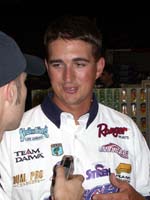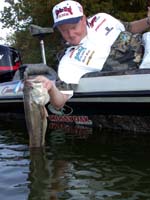
|
Features
|
|
|
|
Books
|
|
|
|
Fun & Games
|
|
|
|
Contact Us
|
|
|
John's Journal... Entry 253, Day 5
BEST NEW TACTICS OF THE PROS
Three Bass Tactics That Work
Editor's Note: Have you wondered what's hot and what's not in the world of bass fishing? Has a new tactic caught on fire, promising to change the way we all fish for bass like dropshotting and flipping have in years past? Or, have anglers re-explored and dusted-off old techniques that once again have proved their value as significant bass-catching strategies? What's the inside scoop on the way professional bass anglers fish to produce the most and the biggest bass? Here's the answers to these questions as we all look forward to the 2004 Bassmaster Classic to be held at Lake Wylie in July, 2004.
 Jim
Bitter: Try Speed Worming - Jim Bitter from Fruitland Park, Florida has
fished as a professional for more than 16 years and has 31 top-10 finishes.
He's won over $700,000 in BASS tournaments. "When Zoom came out with its
new Speed Worm with a paddle tail, I started fishing it," Bitter comments.
"I used the Speed Worm at Lake Okeechobee in Florida and caught two 7-pounders
back to back. I was buzzing the Speed Worm close to the surface on 20-pound-test
line with a No. 3/0 wide gap hook across the surface of the bedding areas.
The key to getting the Speed Worm to work properly is to use a high-speed
reel so you can keep the worm moving fast across the surface. Speed worming
goes against almost everything you know about plastic worm/bass fishing.
Most other plastic-worm tactics are slow moving or target-oriented. However,
for the best results, fish the Speed Worm like you do a spinner bait.
I predict that speed worming will be one of the hottest new tactics in
2004."
Jim
Bitter: Try Speed Worming - Jim Bitter from Fruitland Park, Florida has
fished as a professional for more than 16 years and has 31 top-10 finishes.
He's won over $700,000 in BASS tournaments. "When Zoom came out with its
new Speed Worm with a paddle tail, I started fishing it," Bitter comments.
"I used the Speed Worm at Lake Okeechobee in Florida and caught two 7-pounders
back to back. I was buzzing the Speed Worm close to the surface on 20-pound-test
line with a No. 3/0 wide gap hook across the surface of the bedding areas.
The key to getting the Speed Worm to work properly is to use a high-speed
reel so you can keep the worm moving fast across the surface. Speed worming
goes against almost everything you know about plastic worm/bass fishing.
Most other plastic-worm tactics are slow moving or target-oriented. However,
for the best results, fish the Speed Worm like you do a spinner bait.
I predict that speed worming will be one of the hottest new tactics in
2004."
 Chad
Brauer: Use Red for Bass - Twenty-nine-year old Chad Brauer from Osage
Beach, Missouri, has fished professionally for six years. He's won the
1996 Tennessee Top-100, has had nine top-10 finishes and has competed
in the CITGO Bassmaster Classic. "For about a year now, I've been experimenting
with the color red," Brauer mentions. "I believe bass that see red on
a baitfish assume that the red is blood and that the fish is wounded --
offering them an easy meal. My father (Denny Brauer) has been working
with Mustad to help create "Bleeding Hooks." Bleeding Hooks are red. When
they're attached to a crankbait, they give the appearance that the crankbait
is a wounded baitfish that's bleeding. I started changing out the silver
and black hooks that come on most crankbaits and replaced them with Bleeding
Hooks. I now have more confidence in these red hooks then I do the hooks
that come standard on most crankbaits because I catch more bass with the
Bleeding Hooks than I do with dark-colored hooks. Another reason I'm building
more confidence in the concept of bleeding baits is because Strike King
Lure Company has developed a line of baits that have the red bleeding
color on the lures as well as the hooks. I believe that these new Bleeding
Baits present a different-looking lure to the bass that triggers strikes.
I really believe that the red coloring on these lures has caused me to
catch more bass this year than I did last year. If you think about it,
identifying an injured baitfish is what causes the bass to attack one
baitfish instead of another one in a school of baitfish."
Chad
Brauer: Use Red for Bass - Twenty-nine-year old Chad Brauer from Osage
Beach, Missouri, has fished professionally for six years. He's won the
1996 Tennessee Top-100, has had nine top-10 finishes and has competed
in the CITGO Bassmaster Classic. "For about a year now, I've been experimenting
with the color red," Brauer mentions. "I believe bass that see red on
a baitfish assume that the red is blood and that the fish is wounded --
offering them an easy meal. My father (Denny Brauer) has been working
with Mustad to help create "Bleeding Hooks." Bleeding Hooks are red. When
they're attached to a crankbait, they give the appearance that the crankbait
is a wounded baitfish that's bleeding. I started changing out the silver
and black hooks that come on most crankbaits and replaced them with Bleeding
Hooks. I now have more confidence in these red hooks then I do the hooks
that come standard on most crankbaits because I catch more bass with the
Bleeding Hooks than I do with dark-colored hooks. Another reason I'm building
more confidence in the concept of bleeding baits is because Strike King
Lure Company has developed a line of baits that have the red bleeding
color on the lures as well as the hooks. I believe that these new Bleeding
Baits present a different-looking lure to the bass that triggers strikes.
I really believe that the red coloring on these lures has caused me to
catch more bass this year than I did last year. If you think about it,
identifying an injured baitfish is what causes the bass to attack one
baitfish instead of another one in a school of baitfish."
 Mark
Rose: Fish Small and Heavy for Spots - Mark Rose, age 31, of Marion, Arkansas,
has competed professionally since 1999 and has had several top-20 and
top-10 finishes in bass tournaments. "This year I learned to fish smaller,
heavier spinner baits in deep clear lakes to catch spotted bass," Rose
explains. "Initially, I'd take a Strike King Pro-Model spinner bait, cut
an inch off the wire to shrink the bait and add lead to the lure to get
it down deeper. I had to re-bend the wire to make the spinner bait react
properly. I caught more spotted bass than the anglers who were fishing
the big heavy spinner baits or little bitty spinner baits. Little spinner
baits were almost the right size, but they weren't heavy enough to get
down deep. Big spinner baits were heavy enough to get down deep, but they
were too big for the spotted bass. Now Strike King has come out with the
Silhouette Models. These factory-made, small, heavy spinner baits will
get down deep in clear lakes, and I've learned that spotted bass will
really eat them up."
Mark
Rose: Fish Small and Heavy for Spots - Mark Rose, age 31, of Marion, Arkansas,
has competed professionally since 1999 and has had several top-20 and
top-10 finishes in bass tournaments. "This year I learned to fish smaller,
heavier spinner baits in deep clear lakes to catch spotted bass," Rose
explains. "Initially, I'd take a Strike King Pro-Model spinner bait, cut
an inch off the wire to shrink the bait and add lead to the lure to get
it down deeper. I had to re-bend the wire to make the spinner bait react
properly. I caught more spotted bass than the anglers who were fishing
the big heavy spinner baits or little bitty spinner baits. Little spinner
baits were almost the right size, but they weren't heavy enough to get
down deep. Big spinner baits were heavy enough to get down deep, but they
were too big for the spotted bass. Now Strike King has come out with the
Silhouette Models. These factory-made, small, heavy spinner baits will
get down deep in clear lakes, and I've learned that spotted bass will
really eat them up."
Professional bass fishermen consistently catch more bass than most of us do because they constantly try out new techniques and lures and also reuse old tactics by refreshing them and treating them like they're new strategies. The best bass fishermen in the world have learned these methods this year. If you'll use these tactics, you'll start catching bass like the pros do.
To learn more about Strike King's lures, go to www.strikeking.com.
For more information on Zoom, visit www.zoomworms.com.
Check back each day this week for more about BEST NEW TACTICS OF THE PROS ...
Day 1 - Three of the Latest
Techniques
Day 2 - Three More Best Ways To Take Bass
Day 3 - Three More Pro Bass-Catching Methods
Day 4 - Three Pros Teach You
Day 5 - Three Bass Tactics That Work